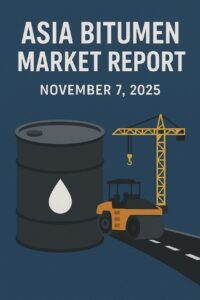
Asia Bitumen Market Report – 7 November 2025
Executive Summary
The Asian bitumen market is navigating a mixed landscape as of November 2025. On one hand, crude oil and high‑sulphur fuel oil (HSFO) price pressure provide upward support for bitumen pricing, while on the other hand, weakening demand in several key Asian markets—especially Southeast Asia—and ample supply are constraining price momentum. Over the medium term, the region’s robust infrastructure and paving programmes suggest solid demand growth ahead, particularly in South Asia and China. The Asia‑Pacific region held over 30 % of the global bitumen market in 2024 and is projected to grow steadily. In short: near‑term price environments are under pressure from demand softness; longer‑term structural fundamentals remain supportive.
Market Dynamics
Demand Trends
In Asia, weak uptake has been noted, particularly in Southeast Asia and India, where wet weather and high inventory levels are constraining imports. China’s bitumen market shows regional variation: supply tightness in South China pushes prices up, but in East China, steady but moderate consumption keeps prices contained. Infrastructure programmes in India, Indonesia, Vietnam, and Malaysia remain potential demand drivers, although timing of tendering and funding remains a risk.
Supply & Pricing
Crude oil price movements (Brent around US$65/bl in late October) and HSFO levels play a prominent role in setting bitumen costs. Export prices in Singapore for late‑October loaded cargoes were quoted at US$393‑400/t, down about US$1/t week‑on‑week, reflecting subdued demand and competitive offers from China. Some regional markets such as South Korea recorded price increases (≈US$6.88/t) owing to tighter local supply.
Regional Outlook
- Southeast Asia presents a fragmented picture. Malaysia’s demand is rising under new road‑project momentum, but Indonesia remains weak due to project delays and inventory overhang
>In South Asia, demand remains muted but has structural upside if monsoon season ends and roadworks accelerate
- China and Northeast Asia show mixed momentum depending on regional weather, fuel/oil input costs, and refined bitumen availability.
Macro & Structural Drivers
The Asia‑Pacific bitumen market was valued at approximately US$22.2 billion in 2024 and is forecast to reach roughly US$32.8 billion by 2033—implying a compound annual growth rate (CAGR) around 3.9% from 2025‑33. Globally, the market is projected to grow from US$75.6 billion in 2025 to US$98.6 billion by 2032, with Asia‑Pacific holding about 30% share. Key drivers include urbanization, highway expansion, smart‑city frameworks, rural road connectivity and rising use of polymer‑modified bitumen (PMB) and other enhanced binders. Challenges remain: raw‑material feedstock volatility, weather‑seasonal slowdowns, and regulatory/environmental pressures.
Outlook & Strategic Implications
Short term (next 3–6 months): Price pressure likely to persist given weak demand in key markets, unless there is a sudden surge in activity.Medium term (12–24 months): Structural infrastructure programmes in India, China, and ASEAN offer growth potential.
- Suppliers may offer more competitive pricing to maintain volumes; buyers may benefit from leverage.
- “Monitor the tender calendar of road construction projects.”
- “Offer value-added products such as PMB or eco-friendly bitumen.”
- “Hedge feedstock costs whenever possible.”
Key Takeaways
- 1. The Asian bitumen market is in a transitional phase: supply remains ample, pricing under pressure, yet structural demand remains intact.
- 2. For suppliers: tiered product offering and cost control will be crucial.
- 3. For buyers/importers: current market offers negotiation opportunities, but project timing remains a critical variable.
- 4. For investors/analysts: long‑term growth in Asia remains robust (~3.9% CAGR), but near‑term volatility requires operational flexibility
